What is the difference between green, white and black tea? Are all based on original tea leaves?
4 Answers
White, green, oolong, and black tea are all products of Camellia sinensis leaves and buds, the only difference is how they are processed. You can turn the plant matter into any of the varieties. Different sources will give different accounts of the processing steps, but in rough order of least-to-most processed:
White tea is minimally processed and not oxidized, meaning it retains the natural antioxidants, but does not develop as much flavor, color, or caffeine. Sweet or flowery flavors are characteristic.
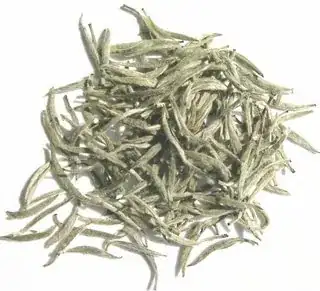 (Chinese Silver needle white tea)
(Chinese Silver needle white tea)
Green tea has a minimal amount of oxidation, halted by additional pan-frying (Chinese teas) or steaming (Japanese) steps. The additional processing brings out more flavor, and allows for caffeine to develop, at the cost of a reduction in antioxidants. Characteristic flavors are grassy, vegetal, and earthy, with sweet notes.
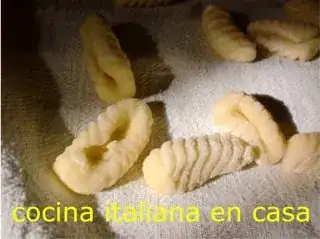 (Japanese Sencha)
(Japanese Sencha)
Oolong tea gets partial fermentation, and often an additional shaking/bruising step that release additional flavors. Oolong can range in color from dark green to black. The combination of bruising and partial fermentation give many oolongs distinct flowery & earthy flavors. Darker oolongs may have buttery or smoky tastes to them. It has somewhat more caffeine and less antioxidants than green tea.
Tieguanyin or Iron Goddess: (light oolong)
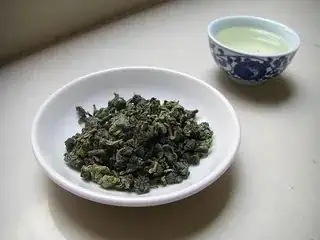
Black Oolong: (Wu Yi)
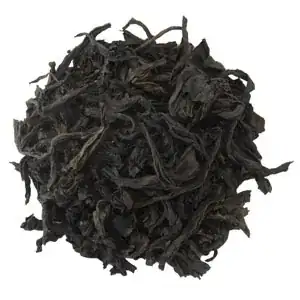
Black tea is fully fermented, which blackens the leaves and causes the formation of caffeine and tannins. It generally possesses the most robust flavor and highest level of caffeine, but the least antioxidants.
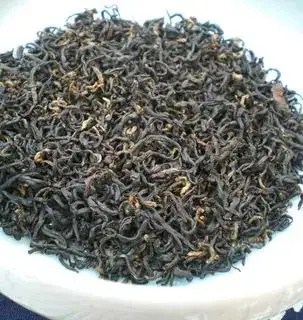 (Chinese keemun)
(Chinese keemun)
Pu-erh is tea that is pressed into cakes and post-fermented, meaning that after processing and drying it undergoes an additional ripening/fermentation. Microorganisms work on the tea, changing it chemically in a similar fashion to aging cheeses. Traditionally this is accomplished over years in controlled climate conditions (10-15 years being ideal), but in recent decades a several-month fast ripening process is sometimes used.
Pu-erh develops a richer, more complex flavor, and has the widest range of flavors of any of the varieties. Before post-fermentation, it may resemble a white, green, or oolong tea, but the ripening process can impart darker black-tea flavors, giving a unique character.
Pu-er Cake

Rooibos, sometimes called red tea, is made from another plant entirely, Aspalathus linearis. It is a traditional South African infusion, prepared like a black tea but without caffeine. There are two varieties, green and red. Green is un-oxidized, where red is oxidized. Rooibos is characterized by a sweet, woody/malty flavor. Health-wise, it is a source of anti-oxidants, may aid in digestion, and some say it may aid with nervous tension and allergies.
Yerba mate is from the South American plant Ilex paraguariensis, whose leaves are steeped like tea. It is generally toasted in processing, and produces a brew with caffeine similar to coffee. Despite its caffeine, mate is actually relaxing to smooth muscles, so you don't get jitters, and it also helps control appetite. The flavor is vegetal and herbal, and can be bitter if brewed hot. Although it contains antioxidants, this is balanced by traces of carcinogens from the toasting, and the jury is still out on whether mate overall increases or decreases cancer rates.
Tisanes or herbal infusions these are various blends of dried herbs, fruits, spices, and flowers which are steeped like teas, but do not contain tea leaves. Generally, the ingredients are dried, although fresh ingredients can be used too. To confuse matters further, black and green teas may also have flavorings added to them, giving a similar result.
-
I would only make one addition to this very good answer. [Rooibos tea](http://en.wikipedia.org/wiki/Rooibos) is the one that does not come from *Camellia sinensis* but rather from *Calicotome villosa*. – nico Sep 06 '12 at 07:04
-
4@nico Ah, but if we're going to talk about *tisanes*, and not just *tea* then I'd also have to go into yerba mate, traditional herbal infusions (chamomile, hibiscus, nettle, mint) and more... which I might, I suppose. Goodness knows I could say enough about them, as someone who sells tea for a living. – BobMcGee Sep 06 '12 at 12:47
-
sure, although I have almost always seen Rooibos classified with teas rather than tisanes... – nico Sep 06 '12 at 13:58
-
@nico *grumble grumble grumble* Oh, fine, I'll put it in there. I guess I'm just a bit of a purist. But I insist on pronouncing it the Afrikaans way (roo-ibus, not ROY-bos). :-P – BobMcGee Sep 06 '12 at 14:16
-
Only difference? where it has been grown (soil temp water)has it's effect too on what would be the same cuppa – Pat Sommer Sep 06 '12 at 21:36
-
2@PatSommer *Terroir* does impact the quality of the product, and some leaves lend themselves more to certain style. However, you can use the same leaves and buds to make any of the styles. – BobMcGee Sep 06 '12 at 22:42
-
You forgot kava... – g33kz0r Sep 21 '12 at 21:01
-
@g33kx0r That would be because I know nothing about kava... – BobMcGee Sep 22 '12 at 01:59
-
An anonymous user suggested an edit stating that Roiboos is actually made from the plant Aspalathus linearis, not Calicotome villoso. Can somebody confirm or disprove that information? – rumtscho Sep 23 '13 at 12:43
-
@rumtscho It looks like the anonymous user is correct, I am editing my answer – BobMcGee Sep 24 '13 at 03:17
-
1Although this is a nice answer, it repeats the old canard that the level of caffeine is somehow tightly tied to the level of oxidation. This is not the case: http://cooking.stackexchange.com/q/33824 and see also the table of caffeine content of teas in _Tea: history, terroirs, varieties_ (p. 254). – András Salamon Sep 26 '13 at 09:47
-
I support the statement that we should focus our answers on 'tea' made from the Camellia Sinensis tea plant, in order to understand the differences between the tea types mentioned in the original answer. – Lisa at Teasenz.com Nov 22 '16 at 03:55
-
It's a general misconception that white tea is not oxidized. The moment you pick the tea leaves, the withering process and during this process the oxidation of leaves already starts. – Lisa at Teasenz.com Nov 22 '16 at 04:12
Green tea is made solely from the leaves of Camellia sinensis that have undergone minimal oxidation during processing. (For more information on processing: see here) (Source)
White tea comes from the buds and leaves of the Camellia sinensis plant. The leaves and buds are allowed to wither in natural sunlight before they are lightly processed to prevent oxidation or further tea processing. The name "white tea" derives from the fine silvery-white hairs on the unopened buds of the tea plant, which gives the plant a whitish appearance. The beverage itself is not white or colourless but pale yellow. (Source)
Oolong is a traditional Chinese tea (Camellia sinensis) produced through a unique process including withering under the strong sun and oxidation before curling and twisting. (Source)
Black tea is a type of tea that is more oxidized than oolong, green and white teas. All four types are made from leaves of the shrub (or small tree) Camellia sinensis. Black tea is generally stronger in flavor than the less oxidized teas. (Source)
- 3,060
- 5
- 26
- 45
-
4Not a bad summary, but as a tea professional I should add a couple notes with my +1 vote. One, buds are common in better white, oolong, and black teas. In black teas they turn a delightful golden shade (particularly eyecatching in golden Yunnan teas). Withering may also be used for multiple styles of tea, not just white. White is distinguished by lack of oxidation/fermentation beyond the withering. Tea processing is unfortunately a rather complex subject, and there's a lot of variation in how various farms do it, beyond the most basic parts. – BobMcGee Sep 06 '12 at 18:23
Let me answer this shortly and effectively:
All teas come from the same tea plant (Camellia Sinenses) though there are different cultivars.
Teas are classified based mainly on the degree of oxidation. Green tea is minimally oxidized and maintain its green color. Black tea is fully oxidized, hence its black color. In between, you've oolong teas, which are partially oxidized. They can be greener or darker depending on their specific degree of oxidation.
White versus green tea processing
White and green tea processing is fairly similar and so are their oxidation levels. Because it's relatively new category, it doesn't completely fit in the logic above. So it needs some further explanation. The difference lies in the processing steps:
White tea processing steps: Withering --> Drying
Green tea processing steps: Withering --> Fixing --> Drying
Based on what I've seen at farms so far, withering process is generally longer for white tea. When it comes to 'fixing', in China we mainly panfry the leaves. In Japan, the steaming method is used the most.
What has to be said for white tea though, is that this tea type can sometimes be stored for further aging. Especially white tea cakes. So overtime the oxidation level of white tea changes.
I hope I've not made it too complex.
- 1,046
- 7
- 8
white tea About 10 to 30% of the fermentation
but black tea is Fermentation degree of 80 to 90% of the whole fermented tea
- 58,386
- 30
- 196
- 321
- 1